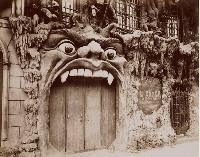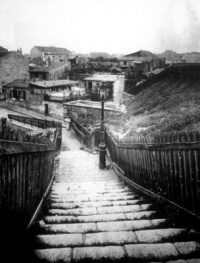Eugène Atget
From The Art and Popular Culture Encyclopedia

|
"Atget's Paris photos are the forerunners of Surrealist photography" --Walter Benjamin, A Small History of Photography |

|
Related e |
|
Featured: |
Eugène Atget (February 12 1857, Libourne, Gironde - August 4 1927, Paris) was a French photographer noted for his photographs documenting the architecture and street scenes of Paris.
Contents |
Early life
Born in the French city of Bordeaux, he was orphaned at seven and raised by his uncle. In the 1870s, after finishing his education, Atget briefly became a sailor and cabin boy on liners in the Transatlantic. After shipping on several voyages, Atget became an actor, more specifically, a bit player, for a second-rate repertory company, but without much success.
Photography career
Atget finally settled in Paris, as a painter-turned-photographer in the 1890s. Despite Atget's limited background in the visual arts, he saw photography as a source of income, selling his photographs to artists in the nearby town of Montparnasse. He advertised his photographs as "documents for artists." It was common practice at the time for painters to paint scenes from photographs. By the mid-1890s, Atget bought his first camera and began to photograph more than 10,000 images of the people and sights of the French capital. By 1899, he had moved to Montparnasse, where he lived and earned a modest income until his death in 1927.
Atget photographed Paris with a large-format wooden bellows camera with a rapid rectilinear lens. The images were exposed and developed as 18x24cm glass dry plates. Besides supplying fellow artists, architects, publishers, and interior decorators with his photographs of a dream-like Paris, he was also commissioned by city bureaus and the Carnavalet Museum to preserve and record landmarks in France's capital city.
Distinguishing characteristics of Atget's photography include a wispy, drawn-out sense of light due to his long exposures, a fairly wide view that suggested space and ambiance more than surface detail, and an intentionally limited range of scenes avoiding the bustling modern Paris that was often around the corner from the nostalgia-steeped nooks he preferred. The emptiness of most of his streets and the sometimes blurred figures in those with people are partly due to his already antiquated technique, including extended exposure times he required.
The mechanical vignetting often seen at some corners of his photographs is due to his having repositioned the lens relative to the plate on the camera (this is one of the features of bellows view cameras)--this is a way to correct perspective and control the image. Under the dark cloth, Atget surely knew the effect of these corners and accepted or preferred them. In fact, one of the key qualities of Atget's work compared to the many other similar documentary workers of that city, is his savvy avoidance of perfection, that cold symmetry and clear stasis that photography is so naturally good at. He approaches his subjects with a humanism that is palpable once noticed, and you become an observer and appreciator with him in his meanderings. He has often said "I have done little justice to the Great City of Paris" as a comment on his career.
Atget's photographs attracted the attention of well-known painters such as Man Ray, Andre Derain, Henri Matisse and Picasso in the 1920's. Fellow photographer Berenice Abbott is given much credit for the recognition that Atget's photographs received after Atget's death in 1927in France. Just before his death, Abbott, then an assistant to fellow expatriate Man Ray, photographed the aging Atget. When Atget died, Abbott partnered with the American Julien Levy to raise the money to acquire 1,500 of the negatives and 8,000 prints. She spent the next forty years promoting his work in America, elevating it to recognition as art, beyond its original reputation as documentation.
Legacy
In 1968, the Museum of Modern Art purchased Abbott's collection of Atget's work. Abbott wrote of Atget: "He was an urbanist historian, a Balzac of the camera, from whose work we can weave a large tapestry of French civilization." In 1985 MoMA completed publication of a four-volume series of books based on its four successive exhibitoins about Atget's life and work.
Better-known photographs
- Organ Grinder, (1898)
- Cabaret, Rue Mouffetard, (1900)
- Au Tambour, 63 quai de la Tournelle, (1908)
- Le Quai, I'lle de la Cite, (1925)
- Avenue des Gobelins
Books
- The World of Atget, 1964.
- Atget's Gardens: A Selection of Eugene Atget's Garden Photographs, 1979.
- The Work of Atget, 4 vols., 1981-85.
- Eugene Atget: A Selection of Photographs from the Collection of Musee Carnavalet, Paris, 1985.
- Eugene Atget: Paris, 1998.

